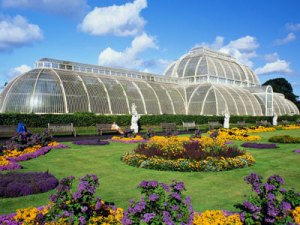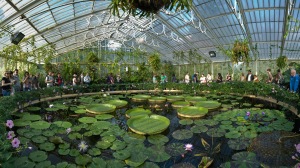
One of the many houses at Kew Gardens via http://www.london-attractions.info/kew-gardens.htm
Today we had the privilege of a very special visit to Kew Gardens, one of the world’s most popular gardens. Prior to 1840 the gardens were owned by the Royal Family, and they currently hold one of the largest collection of living plants! Before we spent the afternoon perusing the gardens’ treasures, we visited the library and archives. There are between seven and eight million sheets of paper in the archives, along with over three hundred thousand books in the library. Our guide Fiona was kind enough to pull some of the most important, fascinating, and significant books for our class to look at. The oldest item in the collection is a herbal book written in Latin from 1370! She explained that, due to the many accurate drawings in the books, they are still used by researchers today despite their age and historical significance. We also visited the Herbarium, which is like a library, but holds dried plant specimens rather than books. The room had a very distinct smell…
Fiona also told us some very interesting facts about Beatrix Potter, the famous author of The Tale of Peter Rabbit and many other children’s stories. Potter conducted research at Kew Gardens, specifically studying and identifying the reproductive elements of fungi. She wrote up her discoveries and had them presented. Because she was considered a naturalist, meaning she was an amateur rather than a professional botanist, and because she was female, she was not taken seriously and her work was quickly dismissed. This is very unfortunate, because her research findings turned out to be completely correct, and botany would have evolved at a much faster rate than it actually did. But despite her slight, she became one of the best known children’s authors and illustrators of her time.
When finished showing us items from the library and archive’s collections, we met Andrew Wiltshire and listened to his talk on Beatrix Potter’s life and legacy. His message was very interesting, and I learned so much about an author that I barely knew. When Potter was young she began keeping a diary in an attempt to escape the oppressive people in her life. But she only wrote in a code she created. Then, in 1958, a man named Leslie Linder finally broke the code, and deciphered her whole collection of diaries. A whole new chapter in Potter’s life was remarkably discovered due to Linder’s efforts. Mr. Wiltshire not only discussed these discoveries, but also pointed out the similarities between Potter and Linder. Mr. Wiltshire also revealed that he and his family were connected to Linder, and he had grown up in the same town with him! We spent the rest of the day exploring the beautiful gardens!
The Royal Botanic Gardens at Kew’s website:

The Waterlily House via http://en.wikipedia.org/wiki/File:Kew_Gardens_Waterlily_House_-_Sept_2008.jpg